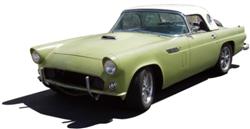There are three advance "stages" to sort out.....
(1) Initial setting - stocker cams like about 10º
(2) Mechanical / Centrifugal - this summed with the initial should be on the order of 36º. This would be the upper limit the heads / compression ratio / octane mix will tolerate at wide open throttle. So you adjust the mechanical to stop advancing at 36º- 10º so you will need 26º at the crank. The distributor is running at 1/2 crank speed so the distributor will need to get 13º. Without directions for the distributor - you are going to have to try it out and see what you have by reading the crank degrees.
(3) Vacuum - The vacuum pot may or may not be adjustable..... but it sums onto the initial + mechanical based on manifold vacuum. This implies a mostly closed or partial throttle condition. On mine - a pretty stock set-up, I have the vacuum limited to 7º. So maximum at cruise is 10+26+7=43º
At idle - the type of vacuum source becomes important to your set-up. If the source is "ported" - no vacuum applied to the distributor pot - you would see the initial setting of 10º until the throttle is cracked. I can tell you - you won't see the best engine idle vacuum at this setting. So many go in and set the initial at a higher value to make the engine happy - but you must obey the upper limit of 36º to avoid detonation elsewhere in the rpm range. Lets say that testing shows best idle vacuum is at an initial 16º - you must then readjust the stops to only add 20º at full mechanical advance. The vacuum advance must then be set pretty "tight" or as the throttle opens, the engine is going to want to go pretty lean. As an alternative - I use this and several others do as well - I use the initial setting of 10º and hook the vacuum pot to live manifold vacuum. On my outfit, the pot is set to stop at 7º and at idle the timing light shows 17º at the crank. The 17º nets the best idle vacuum on my engine set-up and the 10º initial makes it start really nice.
I would suggest doing some experimenting with the "unknown" distributor to find out what its adjustment capabilities really are. You are going to want a timing tape on the damper and a timing light and a vacuum gauge and a tachometer. And in fairly short order - you will have the info to make a good judgement of what to do next.

Steve Metzger Tucson, Arizona